Tired of glasses or contact lenses? LASIK surgery is the ultimate solution for crystal-clear vision without the hassle of specs. At Save Sight Centre, we use the most advanced laser technology to ensure safe, painless, and precise vision correction.
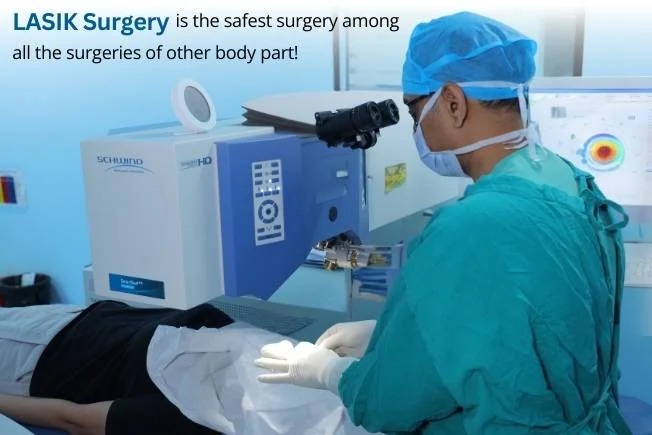
Specs removal surgery, commonly known as LASIK (Laser-Assisted In Situ Keratomileusis), is a revolutionary vision correction procedure that reshapes the cornea to fix myopia (nearsightedness), hyperopia (farsightedness), and astigmatism. The result? Perfect vision without glasses or contact lenses!
We need spectacles because our eyes might not focus light properly on the retina, which can cause blurry vision. This can happen due to issues like nearsightedness (can't see far), farsightedness (can't see close), or astigmatism (distorted vision). Thus, after reshaping the cornea the light focuses correctly on the retina, improving vision.
LASIK surgery corrects the below eye conditions: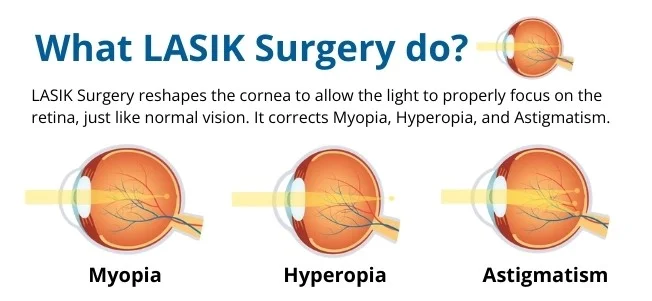
Not everyone is eligible for LASIK Surgery. Firstly, the doctors will check your retinal health. Secondly, they will conduct corneal topography i.e. Pentacam / Sirius. This test will help examine the cornea health and thickness.
| You are eligible if: | You cannot go for LASIK if: |
|---|---|
| You are 18 years or older | You have other serious problems like uncontrolled diabetes, glaucoma, macular degeneration, keratoconus (corneal thinning), etc. |
| Your glass prescription should be stable for 6 Months – 1 Year (0.25 change is considered normal) | You are Pregnant women |
| Your must have healthy eyes |
At Save Sight Centre, we are trusted by thousands for safe and precise LASIK surgery. Here’s why:

Highly Experienced LASIK Surgeons

Advanced and Latest Technology

Customized Patient Approaches

Free Pre and Post Surgery Consultation

No Cost EMI Facility Available

Trusted by 1.5 Lacs Patients
Best eye hospital in Delhi. I visited many of the other eye hospitals before but never seen such a polite behaviour by doctors and other employees as well. I would highly recommend this
I underwent smart surf lasik surgery of my both eyes on 18 November 2024in save sight centre. I had an amazing experience and cooperation from the director to hospital attendant. That was

Reviews
| Type of LASIK Surgery | Power of Glasses | Recovery Time | Cost for Both Eyes |
|---|---|---|---|
| Standard LASIK Surgery | -1 to -8 and +1 to +5 | 1 Week | Upto 20,000 |
| Customized LASIK (C-LASIK) | 1 Week | 30,000 - 40,000 | |
| Sub Bowman’s LASIK Surgery (SBK)(Thin Flap) | 1 Week | Upto 45,000 | |
| Femtosecond (Bladeless) LASIK | 1 Week | 75,000 | |
| TRANS PRK / EPI Contoura | 2-3 Week | 60,000 | |
| Contoura Vision / Topoguided Contour | Can be added with all the above Types | 15,000 | |
| SmartSurf | -1 to -8 and +1 to +5 | 2-3 Weeks | 90,000 |
| ICL / IPCL Surgery | -8 to -18 and +1 to +5 | 1 Week | 90,000 - 1,80,000 |
| RLE / CLE | Any Power | 1 Week | 70,000 – 1,00,000 |
Prices may vary based on consultation and pre-operative assessment.

1. Eye Numbing: Numbing drops are applied to make the procedure painless.
2. Creating the Flap: A fine blade or laser is used to create a thin flap in the cornea.
3. Reshaping Cornea: The excimer laser reshapes the cornea to correct vision.
4. Close the Flap: The flap is carefully repositioned to heal naturally.
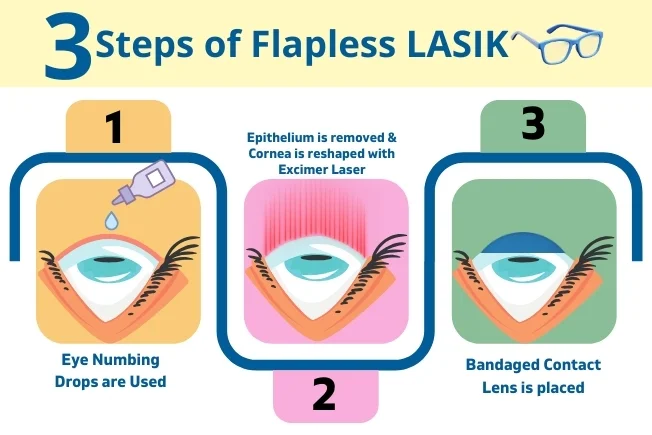
1. Eye Numbing: Ensuring a pain-free procedure, numbing drops are applied.
2. Removing the Epithelium and Reshaping the Cornea: The excimer laser is used to gently uncouple and reshape the cornea for vision correction.
3. Healing: The outer layer of the cornea heals naturally over time. With a contact lens, the healing process is protected during the recovery phase. The BCL, or Bandage Contact Lens, is removed after 5 days.
✔ Avoid makeup, perfume, and other lotions on the day of the procedure.
✔ Have light meals prior to the appointment, and arrange a ride home.
✔ No contact wearing for at least 7-10 days prior to the appointment.
✔ Refrain from using swimming or gym facilities for a minimum of 2 weeks.
✔ Outdoors, use UV protective sunglasses.
✔ Prescribed eye drops should be maintained regularly.
Dr. Rajeev Jain at Save Sight Centre is one of the best refractive surgeons in Delhi. He has over 17 years of experience performing successful LASIK surgeries.
Dr. Shuchi Gupta and Dr. Ankit Malhotra are no less noted for their outstanding LASIK results. Their tireless efforts in patient care and surgical precision, as well as their commitment to ongoing education in refractive surgery, have made them reputable figures in the patient community.

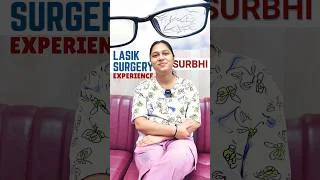

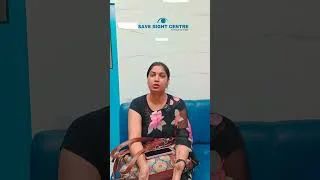
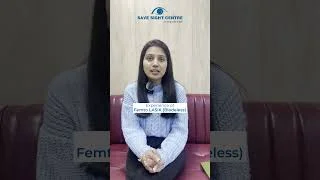
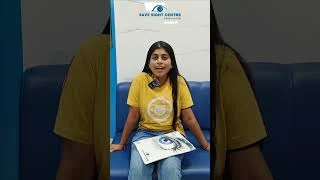
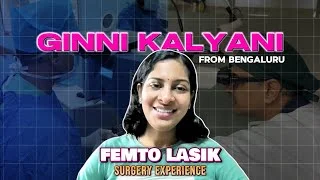


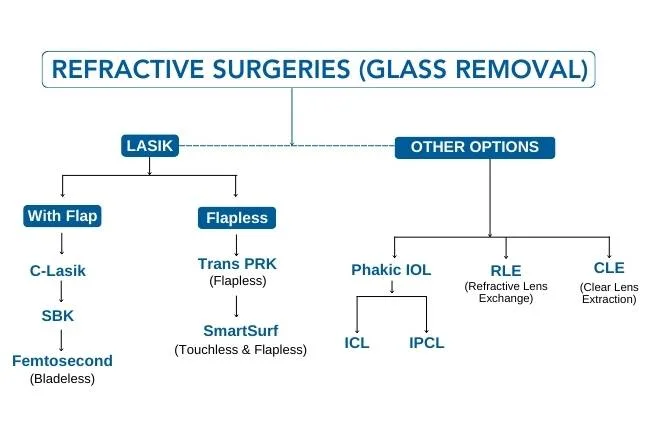
SmartSurf is a touchless, flapless, and one step procedure. This is the latest method to remove glasses. Even when other LASIK types don’t suit at that point also SmartSurf changes the game.
This is the simplest technique because it's mechanized and done in one step. For tissue access, the excimer laser gently removes epithelium from the cornea. It then reshapes the cornea with the same laser.
Finally, a bandage contact lens protects the cornea and epithelium. Five days following surgery, this contact lens is removed. After surgery, the epithelium layer regenerates over a few days.
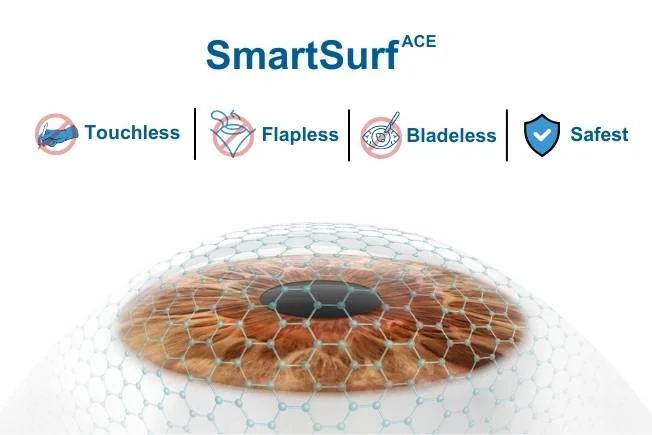
Advantages of SmartSurf Glass Removal Surgery
Femtosecond Lasik is the most common and easier refractive procedure which involves reshaping the cornea with an excimer laser. There is no use of blade, thus it is also named as Bladeless Lasik. This laser is used twice in the surgery, firstly to create a flap and secondly to correct the refractive error.
This is the most efficient, precise, predictable and safe way to correct vision issues for patients with mild to moderate amounts of myopia, hyperopia and astigmatism.
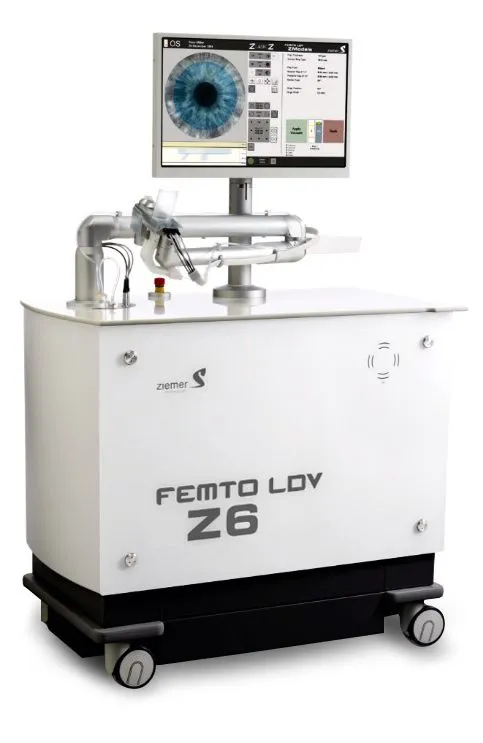
Benefits of Femtosecond:
Topo-guided contour treatment, also known as Contoura Vision, combines prescription with corneal topography maps and provides an improved quality of vision. This is an additional step taken after removing the number. This helps remove the irregularities and aberrations on the cornea. Topo-guided can be added in all types of LASIK:
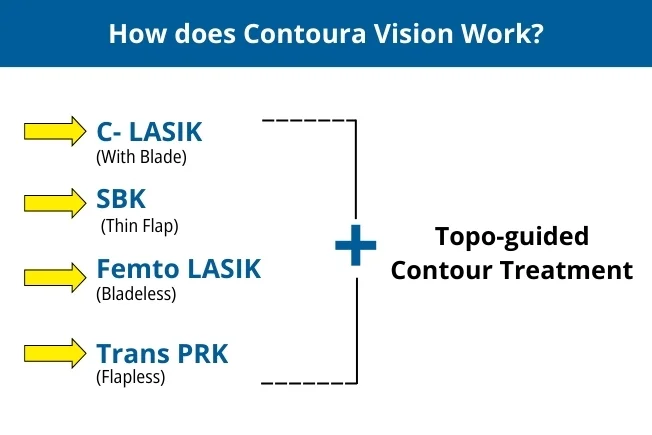
It provides a highly precise and accurate mapping of 22,000 points on cornea which can identify hidden irregularities.
More than 90% of the people treated with Topo Guided Contour experienced a vision sharper than a vision with glasses.
Benefits of Femtosecond:
Trans PRK (Trans-epithelial Photo Refractive Keratectomy) is a technique that allows the laser to access and reshape the cornea without any sort of cutting or creating a flap. This is the upgraded version of PRK. All the steps are done by the machine only and all at once. Thus, it is also known as Touchless and Flapless LASIK.
It is considered the most effective, precise, and advanced technique to correct the refractive errors and has been popular for its touch-free laser eye correction method.

Benefits:
SBK is a more advanced form of traditional LASIK. The procedure still employs a microkeratome blade to form a corneal flap, just like C-LASIK. The difference is that in SBK, more corneal tissue is preserved as the flap is created less than Bowman's layer of the cornea making it thinner.
Once the thin flap has been raised, the eyelid is repositioned and the excimer laser is utilized to reshape the cornea in order to achieve the desired vision. The flap is gently placed back into position.

Benefits of SBK:
Customized LASIK, or C-LASIK for short, employs a microkeratome blade to excise a flap of cornea, subsequently using excimer laser to reshape the cornea in accordance with the patient's particular prescription. The “customization” comes from the advanced mapping, wavefront guided or topography guided, which captures minutiae of the patient’s eye, thus providing a more tailored treatment plan. This type of LASIK is better than standard LASIK due to customization features.
This procedure has been proven helpful for the treatment of common vision ailments which include myopia, hyperopia, and astigmatism
Benefits of C-LASIK:
You don’t need to worry! If you are not eligible for LASIK then there are other options like ICL/ IPCL and RLE/CLE.
If you’re not suitable for LASIK due to high power or thin corneas, Phakic IOLs like ICL (Implantable Collamer Lens) and IPCL (Implantable Phakic Contact Lens) can be a great alternative to get rid of glasses or contact lenses.
In this procedure, a special lens is implanted inside your eye without removing your natural lens. It works like putting a contact lens inside your eye – but permanently. This is ideal for people with high refractive errors or corneas not suitable for laser surgery.

Benefits of ICL/IPCL Surgery:
Procedure Steps:
1. Detailed eye measurements are taken before surgery.
2. Local anesthesia (eye drops) is used to numb the eye.
3. A tiny incision is made in the cornea.
4. The folded lens is inserted and gently placed behind the iris.
5. The lens opens up inside the eye and stays in place permanently.
Over 10 million people worldwide have benefited from this technology – a safe and effective solution for clear, stable vision.
RLE (Refractive Lens Exchange) or CLE (Clear Lens Extraction) is a lens replacement surgery similar to cataract surgery – but done for people who don’t have cataracts. It’s usually chosen by those over 40 who want to permanently correct their vision and reduce their dependency on glasses or contact lenses.
In this procedure, your natural lens is removed and replaced with an artificial intraocular lens (IOL) to correct nearsightedness, farsightedness, and presbyopia (age-related reading issues).
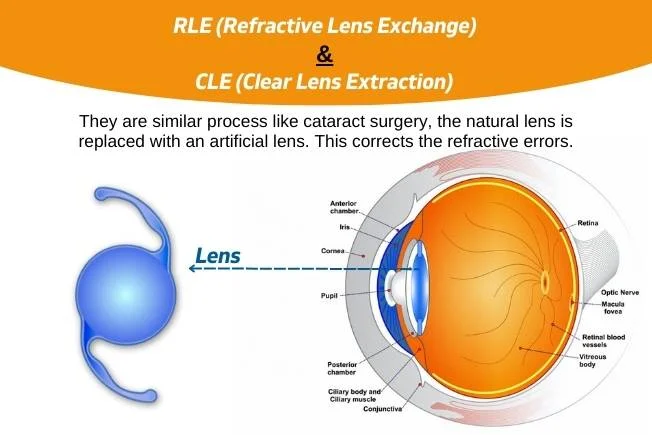
Benefits of RLE/CLE:
Procedure Steps:
1. An eye exam is done to choose the right artificial lens.
2. Eye drops numb the eye – no pain, and you stay awake.
3. A small cut is made to remove the natural lens.
4. The artificial lens is inserted in its place.
5. The cut heals naturally – no stitches needed.
The whole process takes about 10-12 minutes per eye, and most people recover quickly.
LASIK procedures are very safe and FDA-approved for use on human eyes. Like any surgery, there can be rare complications, but these are unlikely if proper screening is done beforehand. Some people may experience mild eye dryness, which can be treated with lubricating drops and usually goes away over time. Others may see temporary halos at night, which also improve with time. After the procedure, mild heaviness and blurred vision are common, caused by the numbing eye drops used. These side effects are rare and can be managed by your doctor. In our experience, no one has ever lost their sight from this procedure.
LASIK provides long-lasting vision correction, but it's not always permanent. Your eyes can change as you age, which might require additional vision correction later in life.
LASIK surgery is usually not painful. Before the procedure, your eye will be numbed with special drops. You might feel some pressure or discomfort, but it's typically brief. Afterward, your eyes may feel a bit scratchy or dry for a day or two but that is manageable by the lubricating eye drops.
You must be 18 or older to be eligible for LASIK. There are more factors to be eligible for this safest surgery of glass removal. Also, the age limit for this surgery is generally considered 45 years as after that you may require glasses for near work.
98% of people are usually suitable for LASIK. If you're not, your doctor may recommend other vision correction options, like ICL, IPCL, RLE.
LASIK can eliminate the need for glasses or contact lenses, but one might need glasses as he/she ages.
LASIK eliminates the power at the present but does not guarantee the lifetime solution. The power may fluctuate in future. Specially, as we age, there is need for glasses for near vision tasks.
LASIK recovery is relatively quick. Most people can return to normal activities within 3 days after the surgery. You might experience some temporary discomfort and fluctuations in vision during the first few days to weeks.
Not everyone is a good candidate for LASIK or other laser eye surgeries. People with certain eye conditions, unstable prescriptions, or health issues like diabetes may not be suitable. Your eye doctor will assess your individual eye condition to determine if LASIK is right for you.
The cost of the LASIK surgery starts at just Rs. 10,000 per eye at Save Sight Centre. However, It depends on your hospital and type of LASIK chosen by you.
If you have any other serious problems like uncontrolled diabetes, glaucoma, macular degeneration, keratoconus (corneal thinning), etc then you should avoid this surgery until your eyes become healthy. Also, Pregnant women are not eligible (as hormonal changes take place).
Follow-ups after LASIK are usually done the next day, the next week, and then monthly for 2 months. Your doctor will guide you on the exact schedule.
LASIK can have side effects, although they are usually temporary. These may include dry eyes, glare, halos, or difficulty with night vision. Serious complications are rare but can occur. It's crucial to discuss potential risks and benefits with your surgeon before the procedure.
You can return to most routine work after 7 days. If your job involves physical labour, liquids, or dust, talk to your surgeon about when it's safe to resume fully.
Copyright © 2025 | Save Sight Centre | All Rights Reserved.